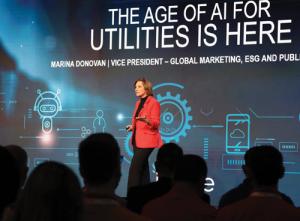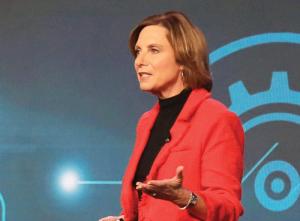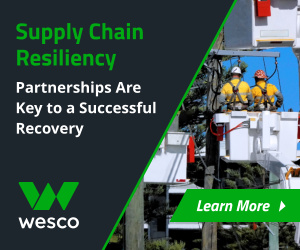Itron
Marina Donovan is Vice President of Global Marketing, ESG and Public Affairs at Itron.
Itron recently released its "2024 Itron Resourcefulness Insight Report," as part of its decade-long research in understanding the perspectives of utility executives and other stakeholders on issues surrounding how energy and water are delivered and used. The importance of the topic this year is yielded in the title, "Exploring AI for Utilities; The Promise and Challenges of Artificial Intelligence."

The report examines the impact of artificial intelligence and machine learning, plus distributed or edge intelligence, among utility executives in six countries: Australia, Canada, France, India, the United Kingdom, and the United States. Facing increased demands on capacity, which are outpacing abilities of traditional approaches, utilities worldwide are looking to a new generation of technologies for help.
Itron Vice President of Global Marketing, ESG and Public Affairs Marina Donovan discussed how population growth, new construction, EV charging, and huge power demands of data centers are putting historic stresses on electric, gas, and water utilities. She also looked at how utility executives plan to take advantage of AI and ML to meet these challenges head on.
PUF's Steve Mitnick: Itron releases each year a major Resourcefulness Insight Report. Talk about that.
 For the 2024 Itron Inspire keynote, Itron’s Marina Donovan discussed findings of the Itron Resourcefulness Report, uncovering the role of artificial intelligence in the utility industry.
For the 2024 Itron Inspire keynote, Itron’s Marina Donovan discussed findings of the Itron Resourcefulness Report, uncovering the role of artificial intelligence in the utility industry.
Marina Donovan: Yes. We've conducted this research, in varying forms, almost every year for more than ten years. We had a couple of exceptions, including during COVID.
I'm responsible for global marketing, ESG, and public affairs at Itron. I make the decision on what we're going to focus on, and that decision is a result of meetings with my team. This year, we also got input from Michael Webber at the University of Texas at Austin. We had a couple of conversations that shaped our area of focus, in addition to socializing it with our leadership.
PUF: What's the focus of this year's Resourcefulness Insight Report and why did Itron publish a report like this?
Marina Donovan: This year's report looks at the current trends and future expectations of artificial intelligence (AI) and machine learning on utility operations and strategies. In terms of the report, we are always looking to figure out where there's a gap of information in the industry.
 Marina Donovan: One area we’ve been working on for several years is adding more intelligence to the grid and providing more computing power in endpoints and meters. Those endpoints connect to the network and give the utility more insights than they’ve ever had before.
Marina Donovan: One area we’ve been working on for several years is adding more intelligence to the grid and providing more computing power in endpoints and meters. Those endpoints connect to the network and give the utility more insights than they’ve ever had before.
Not a lot of research has been published about AI for utilities, and this was a six-country study. We looked at data and analytics because they're key drivers for grid edge intelligence, and that is the future of our company.
Those technologies are shaping the industry. They're foundational to what we're doing. That's why we decided to pursue this topic.
It's also because of what you can do with AI. The report talks about AI, and I'll go into it in more detail, but it enables the utility to optimize operations and to mitigate or prevent any kind of potentially dangerous situations.
PUF: Give a flavor for how extensive this research is.
Marina Donovan: It is a process. We start with designing a questionnaire that goes through a few iterations and gets reviewed by our top leadership. We also work with consultants that help us conduct the online survey and analyze the results.
This year, we reached out to utility executives from six countries: the U.S., Canada, France, the UK, India, and Australia. From there we collected the data, and had the fun job of analyzing it, synthesizing it, and packaging it. The goal is to educate our customers and prospects in the industry about these important topics.
PUF: In a survey, it matters what you ask, and you must have spent a lot of time thinking about what insightful information for the industry would be.
Marina Donovan: One of the first things we contemplated was to confirm why the growth of the grid is expected to double or triple in demand over the next decade. That is mind boggling.
How are we going to address that? Then in our conversations, we realized what's interesting about AI is it presents a problem, but it's also a solution because it can help create efficiencies to address demands on the grid.
One of the biggest takeaways from the report is that AI and cloud computing are contributing to the demand for electricity but are also a solution to helping manage it, along with the other challenges like aging infrastructure, sustainability initiatives, and providing safe, reliable, and affordable energy. AI is part of that solution.
PUF: In a survey, it's who you ask, and what kind of participation you get. Talk about that.
Marina Donovan: Our criteria included utility executives at a certain level, and all that methodology is spelled out in the report. We talked to six hundred utility executives, a hundred executives per each country that I mentioned.
PUF: What was most important that the reader would learn from the survey?
Marina Donovan: At NARUC's meeting, we heard discussions about the need for the grid's capacity doubling or tripling in the next decade. I was happy to hear that conversation taking place amongst regulators.
But then I wanted to know what is driving that demand? The number one answer is data centers for AI and cloud computing. About forty-five percent of our survey respondents said that is what's driving the demand on the grid.
Then we had a tie for the second biggest driver of energy demand. One was sustainability initiatives at thirty-two percent, because some state and local governments have sustainability mandates that they're trying to adhere to, which tied with new residential and commercial construction.
The third area driving energy demand growth was a bit of a three-way tie. First, crypto mining is driving demand, with a lot of strain on the grid.
Second, with regulatory mandates, people are trying to work cleaner and smarter. That was followed by heating and cooling electrification at about twenty-eight percent.
PUF: Did you find that in the six surveyed countries everybody's saying the same thing?
Marina Donovan: Yes, globally as a trend, people were on the same page. There were nuances with the precise stats, but in general, they view these problems or solutions in a similar way.
PUF: Is there a call for action from this report?
Marina Donovan: The report breaks down the opportunities, as well as some of the challenges and barriers. The biggest thing is, across the board, everybody needs to get educated.
PUF: Is education a significant challenge? How would you rate that?
Marina Donovan: It's a workable challenge for the industry, but it is a challenge, nonetheless.
The momentum is happening. Everybody needs to get educated about AI and the challenges facing our industry because the demand is driving how to deal with everything from aging infrastructure, environmental pressures, extreme weather, to wildfires to flooding. AI can help solve some of these.
When asked where AI and machine learning can have the greatest impacts, the number one response was detecting and managing dangerous safety situations. That could be anything from a gas leak, a meter that's running too hot, a squirrel that ate a power line that's going to take out power to a neighborhood, or water leak sensors, because water can cause a lot of damage.
Then number two was that AI can help improve business productivity and make us move faster. Number three was around improving consumer engagement. These are the areas where education can have the greatest positive impact.
PUF: Where does Itron fit in this universe about this challenge going forward?
Marina Donovan: One area we've been working on for several years is adding more intelligence to the grid and providing more computing power in endpoints and meters. For example, those endpoints connect to the network and give the utility more insights than they've ever had before.
This is especially important now as we're entering an age with more electric vehicles rolling online, and more consumers purchasing solar. The grid is fifty to a hundred years old, depending on where you live, and wasn't designed to manage all these renewable energy sources.
Itron is playing a key role in helping utilities get ahead of those issues and be able to more proactively orchestrate renewable energy sources. We want to help our customers get the most life out of their investment to provide reliable, affordable, and resilient service.
PUF: What's 2025 going to bring for you and the company?
Marina Donovan: I think the opportunity for Itron and for the industry is to educate all our stakeholders, which includes regulators. Regulatory support came up when we asked, "What would be most helpful to enhance and integrate direction?" Sixty-seven percent of executives said, "We need more proven technology."
Fifty-one percent said, "We need more regulatory support," because that regulatory process can take a long time. We need people to get on board. Then the third issue, which is so important, forty-eight percent said employee education.
It's difficult too, because we are going into new territory. At Itron, we have some fantastic innovators and engineers, and our grid edge intelligence capabilities are already available and in the field.
It's not that utilities need to rip out and replace everything. They can add or extend to what they've already invested with Itron. Our opportunity as a company, an obligation too, is to help with that education.
PUF: Your customers, the utilities, are bringing in a lot of people who understand how to deal with AI.
Marina Donovan: This is something I am passionate about, and I want to call out another stat I can elaborate on. Sixty-two percent of U.S. utility executives said their most important data investment priorities included training and input for AI and machine learning models.
Keep in mind, this is new even for tech companies. I know utilities haven't been typically the early adopters, but everybody needs to lean in and learn as much as possible.
The second most important data investment priority was improving data quality and inaccuracies; you need to have the right data. Third, at fifty-five percent, was addressing latency or the real-time nature of data.
This is a big topic, industry wide. Change management's probably an old term for this, but it's about educating people on what's available, what they can do, and figuring out a way for them to embrace it.
PUF: If a utility leader asked, "What should we be doing?" What would you say?
Marina Donovan: Every utility is at a different place. There's no blanket answer. Eighty-six percent of utility executives globally said AI is extremely important. In the U.S., it varied to eighty percent.
One of the global questions was, "Where are you on your journey?" I was shocked at how many utilities said that they had deployed AI already.
Eighty-one percent said they're adopting AI machine learning technologies and twenty-five percent had AI fully integrated into operations. Then fifty-six percent said they made significant investments.
Nineteen percent are piloting projects. Utilities are further into their AI journeys than I thought.
We revealed this report at our annual conference, Itron Inspire. Our keynote speaker, Todd Inlander, the CIO of Southern California Edison, said in his talk that one of their biggest challenges is wildfires.
What they're doing — using AI algorithms to process data from sensors, drones, and other digital tools to quickly identify potential issues — is impressive. Again, addressing safety.
Another example, we just made a public announcement with PG&E, unveiling a new program called EV Connect. It enables a consumer who's got a hundred-amp panel on their home to get a level two electric vehicle charger.
If they want an EV, they can get a level two charger without having to upgrade their panel, which can cost a few thousand dollars. Then the utility won't have to upgrade their transformer or the service to the customer's home, which can cost tens of thousands of dollars. Plus, there's a waiting list to do it.
This was part of our CEO's keynote — it's a demo, which is also on YouTube. If a consumer tries to install their own panel, it could cause an outage or a fire. It could be dangerous.
This new program is allowing customers in the PG&E territory, where over half of the homes only have a hundred-amp panel, to charge quickly on a level two charger. Otherwise, it's going to take them twenty-four hours to do a full charge. It enables them not to have to spend all this money for the upgrade.
It helps the utility save that cost of the upgrade to their system. It also helps them get more engaged with the consumer, because the utilities need to have visibility with consumers and their EVs.
These are just some of the innovations being enabled by our Grid Edge Intelligence solutions. PG&E is using our communications network, as they have been for many years. It's their whole AMI network.
By upgrading to just a few meters — we call them spokes meters — with our distributed intelligence capability, the utility uplevels the whole network without major upgrades.
PG&E has a document called their True North Strategy, and it’s over a hundred pages. They have an entire section on AI and the different initiatives it’s going to help them work on. The strategy document is one of the best pieces I’ve seen.
PUF: Where can people go to access the report and the research?
Marina Donovan: You can access the report and download the research, including country-specific results, at www.itron.com/resourcefulness.



